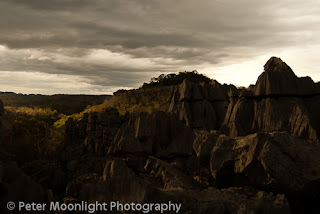From nose to tail,
Brookesia minima stands less than 2cm long. Many creatures are smaller, countless insects and other invertebrates, but
B. minima is a fully fledged reptile.
Probably the world's smallest chameleon - undiscovered species may be smaller - the dwarf chameleon's insignificant frame hides a pair of lungs, a brain, and a tiny heart. They are miniature ambush predators, slowly stalking through their monopoly-board sized leaf-litter territories, changing colour as they go. When prey is sighted, usually a fruit fly,
B. minima angles both its independantly-controlled eyes forward, quickly judging distance. Despite their famed reflexes, few fruit flies can outmaneuver a
B. minima's tongue, which grabs the fly before retracting it into its mouth, where it is greeted by a row of tiny teeth.
Brookesia minima is just one of the wonders of Madagascar's forests. Isolated since the time of the dinosaurs, Madagascar has a unique flora and fauna. Over 90% of its known species are found nowhere else. This includes the lemurs, a group of around one hundred primate species, most of which have been discovered in the last 20 years. Madagascar's lemurs are preyed upon by the fossa, an enigmatic if ugly relative of the weasel.
In Madagascar, geckos impersonate bark, insects impersonate lichen, and chameleons impersonate their surroundings. Aye-ayes fulfill the roll of woodpeckers, rodents fulfill the roll of rabbits, and tenrecs fulfill the roll of just about everything else. Malagasy evolution has ripped the rulebook in two, resulting in primevally odd creatures whose strangeness is only enhanced by Madagascar's unearthly landscapes.
A new BBC wildlife documentary series,
Madagascar, is debuting tonight on BBC Two tonight at 8pm. As with all flagship BBC nature documentaries, the series will doubtless be cinematographically flawless, tell the island's story fluently, and leave the viewer awed.
Madagascar, though, is a conservationists worst nightmare. I was lucky enough to visit the Indian Ocean nation in 2008 and certainly left with a feeling of awe but this was tainted by another emotion: horror. Madagascar's conservation situation is truly dire.
A transport map of Madagascar would look like a wheel. The major towns and tourist sights are all dotted around the country's edge except for the capitol, Antananarivo (I did not lean on my keyboard there, that is really how it is spelled). To reach the edge, travelers must either negotiate miles of potholed dirt track or fly. Each flight, regardless of the destination, takes roughly an hour and the view from the window is as follows:
1) Five minutes of Antananarivo suburbs.
2) Fifty minutes of scorched red soil.
3) Five minutes of pristine forest.
All of Madagascar was once forested but its center is now as barren and red as Australia's great central desert. Slash and Burn agriculture has stripped the land bare, leaving only the native's sacred Baobab trees. The Baobabs of Baobab Avenue, a famed tourist beauty spot, only stand alone because the rest of the forest was felled for rice paddies. A previous BBC Documentary,
Planet Earth no less, made no mention of this in a memorable sequence where a balloon-mounted camera drifted between the Baobabs.
Deforestation leaves nothing to stabilise the dry soil. Five years on, the land is either covered by a rampant non-native grass species or gone. Erosion in Madagascar is rapid and catastrophic; canyons often open within days. Red tsingy, a geological feature proudly displayed to tourists, may look as old as time but is in fact an erosional feature present only due to recent deforestation.
Madagascar's wildlife faces is facing a point of no return. It needs more than just another blue-chip documentary highlighting its unique flora and fauna, something to show generations when it is gone. It needs a documentary that highlights the peril the country's wildlife faces, shows why it is worth saving, and can be used as a weapon to help halt biodiversity loss.
I will be watching tonight hoping that the BBC have produced such a weapon and not simply dismissed the conservationists message as something that diminishes valuable ratings.




























